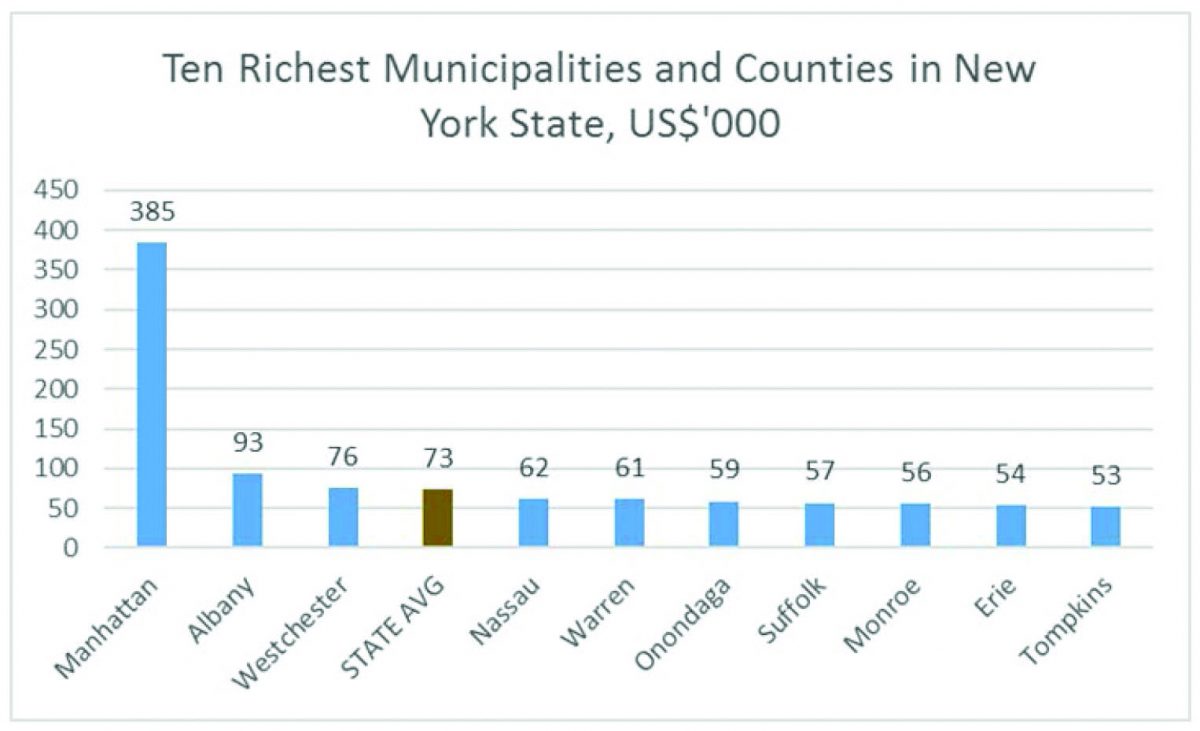Dear Editor,
An alternative to the search for more distant sources of visitors to the Caribbean is to market more selectively within the countries from which our tourists already come. As New York City is a major hub for tourists to the Caribbean, we may use that area as an illustration. The following chart shows the ten richest counties and municipalities in the State of New York, which we use for convenience. In practice you would need to do this analysis for the entire Northeastern area, and repeat it for all the major airports from which visitors fly to the Caribbean.
The average GDP in New York State in 2020 (adjusted for changes in inflation since 2012) was US$73,000. That is already 15 percent above the average of US$63,500 for the United States as a whole. However, the richest municipality, Manhattan (unsurprisingly) has an average income that is five times that of a State that is one of the richest in the nation; average real GDP for Manhattan is the princely sum of US$385,000. Manhattan is home to 1.6 million people. Albany, the State Capital, and Westchester, 27 percent and four percent above the State average respectively, add another 1.2 million potential visitors with extraordinary wealth. The ten largest counties shown between them have a population of about seven million people.
Data of this kind allow for a product development and marketing strategy for tourism, geared to increasing revenues mostly by improving product quality and adding products and services to enhance the appeal of tourist destinations to a wealthier clientele. There are good reasons to seek diversification of source markets through a strategy that distinguishes communities within traditional markets according to their spending power.
In the first place, the Caribbean’s well-established markets in North America and Europe are already well served by airlines who have a stake in the success of Caribbean tourism, which is a significant source of reliable and highly profitable business for them. Their contacts in source markets and their marketing efforts complement those of Caribbean destinations.
Secondly, this strategy can be designed to build on the region’s existing business, by providing services and special attractions and features that build the image of each destination. Every major tourism economy boasts its list of sites and experiences that are unique and unmissable, and the news about them spreads by word of mouth. In that way the grapevine augments the country’s marketing programme.
The Caribbean starts with an advantage over the competition in the European and North American markets from which our tourists mostly come. Visitors from those countries benchmark tourist resorts in the Mediterranean, the Indian Ocean and the Far East against what is on offer in the Caribbean. The Caribbean is also more accessible for most visitors from these areas.
Developing and implementing a value added strategy is more difficult than it may appear, especially in the provision of services. For the most part, hotels, restaurants and other tourism providers will be operating in the middle ground between those for whom money is no object, and the budget-conscious travel market. The majority of visitors from Upstate New York and similar areas will be expecting consistent good quality rather than extravagant luxury. They will also expect services to be as advertised. They will have witnessed too many examples where this has not been the case; to succeed tourism providers are well advised to start with pilot projects, testing and proving them until every detail is perfected, before unleashing a marketing drive. Once established, the new level of quality must be jealously guarded and maintained, with rapid and full compensation should there be any slip.
The added benefit of an up-market strategy is to make the visitor supply more resilient in the face of economic downturns, which are less likely to affect the travel plans of the relatively well-to-do.
Yours faithfully,
Delisle Worrell






